|
 Auricularia cornea Auricularia cornea
SynonymsAuricularia polytricha
Hirneola polytricha
Exidia polytricha
Exidia hispidula
Auricularia auricula-judae
Hirneola auricula-judae
Hirneola hispidula
Auricularia hispidula
Exidia cornea
BiostatusPresent in region - Indigenous. Non endemic
Images (click to enlarge)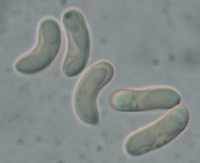
Owner: B. Dee | 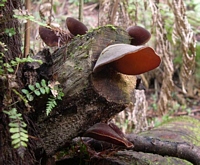
Owner: B. Dee | 
Caption: Auricularia polytricha: h, basidia; i, spores, (All x 1000 approx.) | 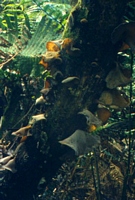
Caption: Auricularia polytricha
Owner: Kaimai Bush | 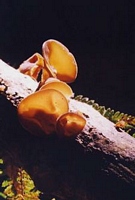
Caption: Auricularia polytricha
Owner: Kaimai Bush | 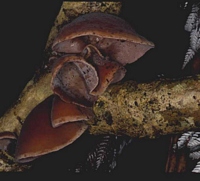
Owner: P.K. Buchanan | 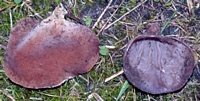
Caption: Auricularia polytricha
Owner: Nils Hallenberg |
Article: McNabb, R.F.R. (1964). New Zealand Tremellales - I. New Zealand Journal of Botany 2(4): 403-414 (http://www.rsnz.org/publish/abstracts.php).
Description: Fructifications tough cartilaginous-gelatinous,
superior surface mouse grey to olive brown when fresh, drying dark olive brown,
inferior surface greyish brown, drying dull brownish black. Substipitate, gregarious
or caespitose, pendent, inversely cupulate, becoming irregularly inversely cupulate
with undulate margins, to 10 cm diam. Superior surface pilose, covered with
thick-walled, hyaline hairs, 5-6 µm diam., up to 450 µm long, apically rounded
or acute, aggregated into tufts. Internal hyphae hyaline, thin-walled, septate,
2.5-5 µm diam., clamp connections present; medulla readily distinguishable,
composed of hyphae arranged parallel to the surface. Hymenium inferior, composed
of dikaryophyses and basidia; dikaryophyses slender, branched, extending beyond
the basidia, becoming strongly agglutinated and metamorphosed, forming a tough
surface layer; basidia cylindrical-subclavate, becoming transverely 3-septate,
50-75 x 5.5-8 µm; sterigmata cylindrical, to 70 µm. long. Basidiospores white
in mass, curved-cylindrical to allantoid, hyaline, thin-walled, obscurely apiculate,
12.5-18.5-(21) x 6-7µm. Germination by germ tubes or by repetition.
Habitat: Angiosperm bark and wood.
Notes: The collections listed above differ in a
number of microscopic details from Lowy's (1952, p. 673) description of Auricularia
polytricha. The basidia are considerably longer and broader than described
by Lowy (50-60 x 4-5 µm) as are the basidiospores (12-15 x 5-6 µm). Spore shape
was not given but illustrations show cylindrical rather than curved-cylindrical
to allantoid spores. In a later work, Lowy (1959, p. 843) described the spores
as curved-cylindrical. The presence of clamp connections was not mentioned in
either description.
A. polytricha was first recorded from New Zealand as Hirneola polytricha by Hooker
(1867, p. 615) and subsequently by Cooke (1879, p. 57), Massee (1906, p. 47),
Wakefield (1915, p. 373), and Lowy (1952, p. 663). It is the commonest auriculariaceous
fungus in the country and may be collected at all times of the year. The fungus
was of considerable economic importance at the turn of the century when large
quantities of the dried fructifications were exported to China for food.
In addition to Auricularia polytricha.
four other species of Auricularia or Hirneola have been recorded
in New Zealand.
Auricularia hispidula (Berk.) Farl. was first recorded by Berkeley (in Hooker 1855, p. 187) as Exidia
hispidula. and later by Hooker (1867, p. 615) and Massee (1906, p. 48)
as Hirneola hispidula. The name is now generally considered a synonym
of Auricularia polytricha and the following collections filed
under Hirneola hispidula at Kew are all of that species. "N.Z.,
Colenso" (3 collections); "N.Z., Canterbury Province, Sinclair and
v. Haast, 1860-61"; "N.Z., Dr Lyall", and "Grey River, N.Z.,
Julius Haast".
Auricularia mesenterica Pers. was recorded from New Zealand by Massee (1906, p. 46) and Lowy
(1952, p. 661) but no collection data were given by either author. Auricularia
lobata Sommerf., which is regarded as a synonym of A. mesenterica,
was recorded by Colenso (1893, p. 322). There are no specimens of either species
at Kew and I have seen no collections of A. mesenterica from New Zealand.
Hirneola auricula-judae (Bull. ex Schw.) Berk. was recorded by Hooker (1867, p. 615), Kirk (1878,
p. 456), and Massee (1906, p. 47). It is now considered a synonym of Auricularia
auricula. Two collections filed under Hirneola auricula-judae
at Kew, viz. "New Zealand, 1850" and "Grey-mouth, N.Z."
are both of Auricularia polytricha.
Article: Cooke, M.C. (1879). New Zealand fungi. Grevillea 8(46): 54-68.
|